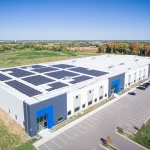2023 Update: After this article was published, major state-level and federal-level policy changes have created improved financing opportunities for solar projects on agricultural operations. The article does not reflect the added savings and shortened payback period resulting from these incentives and grant opportunities. Contact Blue Horizon Energy staff (below) to discuss how you can take advantage of these new conditions.
Pork producers are feeling squeezed by market forces and inflation.
“The cost of diesel is up, the cost of feed is up, the cost of electricity is up.” says Phil Dorr, whose swine operation in Cherokee County, Iowa is responsible for 6,000 hogs annually.
According to Dorr, pork producers like him are uniquely positioned to remove at least one of those rising costs: Electricity. “We had to get these electric bills down — we had to.”
To him, the solution was renewable energy. Specifically solar power. When Dorr started exploring ways to lower his operating expenses, he found that solar power provided benefits that uniquely complemented the scale and usage of a typical Iowa swine barn.
On some residential rooftop solar installations, it can be difficult and even impractical to produce enough power. Shade from trees, irregular roof layouts, and HVAC units can all reduce the number of panels that can fit on a single roof. But the landscape and energy usage of swine barns fit with solar. “We have unproductive land surrounding our barns we’re not using. There are no shade-casting trees in the area either, so this land is an ideal place to install solar panels.”
Dorr is not alone in seeing solar as a way to cut significant expenses.
“A lot of farms can benefit from solar power, but when I look at our clients with the absolute best ROI, they’re all pork operations,” says Hal Kimball of Blue Horizon Energy. “We have pork producers who are operating six barns and are projected to save by 1.4 – 1.9 million dollars in electric expenses over twenty-five years.”
Blue Horizon Energy has led the midwest in bringing solar to agricultural sites. They have kept their field staff busy installing solar power arrays across Iowa and Minnesota.
With solar power, you can take advantage of incentive programs, including the 26% Solar Investment Tax Credit, to effectively purchase more than 25 years’ worth of electricity. This is different from leasing land to a utility company. Instead, the farmer owns the solar array themselves. The power it generates is fed into the electrical meter for immediate use. A grid connection is maintained so that utility-provided power is still there for when the sun goes down. Any excess power produced during the day — beyond what the facility consumes — is fed into the electrical grid. Depending on the utility company, that excess power produces credits that can be banked and used to pay for the utility-provided electricity that’s consumed when the panels aren’t generating power.
Phil Dorr concludes, “My arrays only generate power from sun-up to sunset, but I’m still eliminating 95% of my annual electric bill. The monthly payments toward the solar installation cost less than my monthly utility bill did. When it’s paid off in six years, the remaining 5% of my power is all that’s left of my electric bill for more than twenty years.”
Start a solar conversation today.
Share a few details below and we’ll reach out to you as soon as possible.





